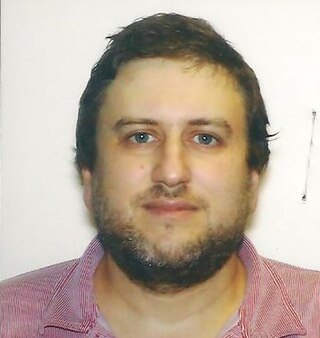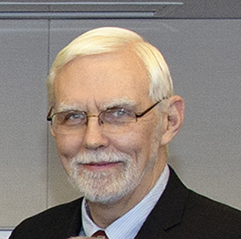Related Research Articles
Quantum key distribution (QKD) is a secure communication method which implements a cryptographic protocol involving components of quantum mechanics. It enables two parties to produce a shared random secret key known only to them, which can then be used to encrypt and decrypt messages. It is often incorrectly called quantum cryptography, as it is the best-known example of a quantum cryptographic task.
This is a timeline of quantum computing.
Quantum information science is an interdisciplinary field that seeks to understand the analysis, processing, and transmission of information using quantum mechanics principles. It combines the study of Information science with quantum effects in physics. It includes theoretical issues in computational models and more experimental topics in quantum physics, including what can and cannot be done with quantum information. The term quantum information theory is also used, but it fails to encompass experimental research, and can be confused with a subfield of quantum information science that addresses the processing of quantum information.
Quantum error correction (QEC) is used in quantum computing to protect quantum information from errors due to decoherence and other quantum noise. Quantum error correction is theorised as essential to achieve fault tolerant quantum computing that can reduce the effects of noise on stored quantum information, faulty quantum gates, faulty quantum preparation, and faulty measurements.
Dorit Aharonov is an Israeli computer scientist specializing in quantum computing.
Joseph Jacobson, is a tenured professor and head of the Molecular Machines group at the Center for Bits and Atoms at the MIT Media Lab, and is one of the inventors of microencapsulated electrophoretic display commonly used in electronic devices such as e-readers. He is the founder of several companies including E Ink Corporation, Gen9, Inc., and Kovio, is on the scientific board of several more companies.
In quantum computing, the Gottesman–Knill theorem is a theoretical result by Daniel Gottesman and Emanuel Knill that states that stabilizer circuits, circuits that only consist of gates from the normalizer of the qubit Pauli group, also called Clifford group, can be perfectly simulated in polynomial time on a probabilistic classical computer. The Clifford group can be generated solely by using CNOT, Hadamard, and phase gate S; and therefore stabilizer circuits can be constructed using only these gates.
Claire F. Gmachl is the Eugene Higgins Professor of Electrical Engineering at Princeton University. She is best known for her work in the development of quantum cascade lasers.

Juan Ignacio Cirac Sasturain, known professionally as Ignacio Cirac, is a Spanish physicist. He is one of the pioneers of the field of quantum computing and quantum information theory. He is the recipient of the 2006 Prince of Asturias Award in technical and scientific research.
Daniel Amihud Lidar is the holder of the Viterbi Professorship of Engineering at the University of Southern California, where he is a Professor of Electrical Engineering, Chemistry, Physics & Astronomy. He is the Director and co-founder of the USC Center for Quantum Information Science & Technology (CQIST) as well as Scientific Director of the USC-Lockheed Martin Quantum Computing Center, notable for his research on control of quantum systems and quantum information processing.
Keith Schwab is an American physicist born in St. Louis, Missouri. His contributions are in the areas of nanoscience, ultra-low temperature physics, and quantum effects.

John A. Smolin is an American physicist and Fellow of the American Physical Society at IBM's Thomas J. Watson Research Center.
Isaac L. Chuang is an American electrical engineer and physicist. He leads the quanta research group at the Center for Ultracold Atoms at Massachusetts Institute of Technology (MIT). He received his undergraduate degrees in physics (1990) and electrical engineering (1991) and master's in electrical engineering (1991) at MIT. In 1997 he received his PhD in electrical engineering from Stanford University.
Hideo Mabuchi is a physicist and Professor of Applied Physics at Stanford University, and the head of the Mabuchi Lab.
Mariangela Lisanti is an American theoretical physicist and an Associate Professor of physics at Princeton University. Her work focuses on understanding dark matter and dark energy using tools developed through artificial intelligence.

Yasunobu Nakamura (中村 泰信 Nakamura Yasunobu) is a Japanese physicist. He is a professor at the University of Tokyo's Research Center for Advanced Science and Technology (RCAST) and the Principal Investigator of the Superconducting Quantum Electronics Research Group (SQERG) at the Center for Emergent Matter Science (CEMS) within RIKEN. He has contributed primarily to the area of quantum information science, particularly in superconducting quantum computing and hybrid quantum systems.
Continuous-variable (CV) quantum information is the area of quantum information science that makes use of physical observables, like the strength of an electromagnetic field, whose numerical values belong to continuous intervals. One primary application is quantum computing. In a sense, continuous-variable quantum computation is "analog", while quantum computation using qubits is "digital." In more technical terms, the former makes use of Hilbert spaces that are infinite-dimensional, while the Hilbert spaces for systems comprising collections of qubits are finite-dimensional. One motivation for studying continuous-variable quantum computation is to understand what resources are necessary to make quantum computers more powerful than classical ones.

G. Peter Lepage is a Canadian American theoretical physicist and an academic administrator. He was the Harold Tanner Dean of the College of Arts and Sciences at Cornell University from 2003 to 2013.

Prineha Narang is an American scientist and quantum engineer. She is an Assistant professor of Computational Materials Science at the John A. Paulson School of Engineering and Applied Sciences at Harvard University. Prof. Narang’s work has been recognized internationally by many awards and a variety of special designations, including the Mildred Dresselhaus Prize, the 2021 IUPAP Young Scientist Prize in Computational Physics, a Friedrich Wilhelm Bessel Research Award from the Alexander von Humboldt Foundation, and a Max Planck Sabbatical Award from the Max Planck Society. Narang also received a National Science Foundation CAREER Award in 2020, was named a Moore Inventor Fellow by the Gordon and Betty Moore Foundation for innovations in quantum science and technology, CIFAR Azrieli Global Scholar by the Canadian Institute for Advanced Research, and a Top Innovator by MIT Tech Review.
This glossary of quantum computing is a list of definitions of terms and concepts used in quantum computing, its sub-disciplines, and related fields.
References
- ↑ Daniel Gottesman's resume
- ↑ "2003 Young Innovators Under 35". Technology Review. 2003. Retrieved August 16, 2011.